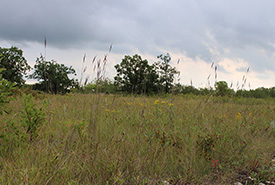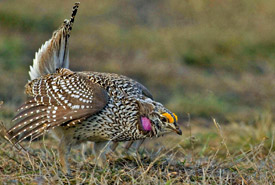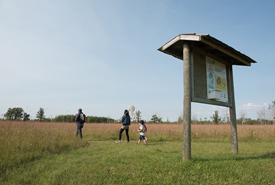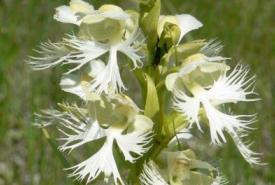The seasons of nature: Witnessing an ever-changing landscape along the Agassiz Interpretive Trail

Agassiz Trail, MB (Photo by NCC)
At the Nature Conservancy of Canada’s (NCC’s) Agassiz Interpretive Trail in southeast Manitoba, a change of seasons brings a different tune to the landscape.
In spring, you may hear sharp-tailed grouse rustling in the forest or chickadees chirping happily around you. Prairie crocuses peek through the flattened, dried grass as summer approaches.
With the warmer weather comes the familiar songs and colourful displays of western meadowlarks, American finches and cedar waxwings.

Male sharp-tailed grouse (Photo by Rick Howie)
Among the bullrushes and two-metre-high big bluestem grass, it’s hard to believe that you’re standing in one of the rarest ecosystems in North America.
“Today, only one half of a per cent of the tall grass prairie remains,” says Tim Teetaert, natural area coordinator for NCC’s Manitoba Region. “It is also one of the most biologically diverse grasslands in the world. The Agassiz Interpretive Trail passes through a meeting place for several vegetation communities of the Tall Grass Prairie Natural Area. Along the trail, as moisture and light levels change, you’ll pass through a number of these.”
Related content
In fall, most of the prairie birds congregate in groups in preparation for their migration south. In winter, you can hear chirps from birds that live here year-round, including chickadees and blue jays.

Agassiz Interpretive Trail, MB (Photo by Thomas Frickes)
The drier areas on the property consist of open grasslands and forested uplands as well as oak savannahs. Decorating the skies are several bird species, including great crested flycatcher, Baltimore oriole and dozens of warbler species, hawks, owls and woodpeckers.
“In and around the sedge meadows are many insects, rodents and birds, including sedge wren, marbled godwit and sandhill crane,” explains Tim. “You may also be able to hear yellow rail. It makes a sound like two small pebbles clicking together.”
These areas provide valuable connections to the surrounding prairie communities. They also offer shelter, food and water to many prairie species. The wetlands on the property are an important part of the landscape, as they help maintain the health of the ecosystem.
“These wetlands also attract a different set of species,” says Tim. “Frogs, snakes, dragonflies, damselflies and bird species, including red-winged blackbird and various waterfowl, live here.”
This area is also home to one of Canada’s most endangered flowers: western prairie white-fringed orchid.

Endangered western prairie white-fringed orchid in the tall grass prairie, MB (Photo by NCC)
“A few years ago during an incredibly wet spring and early summer, I came across an area along the trail where flowered western prairie white-fringed orchids could be seen under at least a foot of water. It looked so strange and cool. About 50 per cent of the global population of this flower occurs in the Tall Grass Prairie Natural Area.”
Tim’s role with NCC has allowed him to gain a greater appreciation for the variety of species this area hosts throughout the year.
“Nature is diverse and self-regulating. It achieves a kind of balance and harmony naturally. Biodiversity is desirable for its own sake, as life is enriched by the existence of many different species. Working for an organization like NCC allows me to be a steward. I am able to use the best available science to hopefully leave the world in a better shape for future generations.”
Year-round, visitors to this area can experience an unforgettable display of the resiliency of a rare prairie ecosystem teeming with wildlife.


